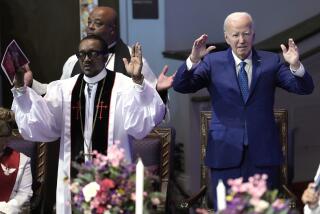Black Churches Gather Their Lost Sheep: AIDS Patients
- Share via
OAKLAND, Calif. — Back when many people thought AIDS was a gay white man’s disease, three black men came to Dr. Robert Scott and told him that they could not bear to confide in their pastors about their infections.
“Each one told me, ‘Whatever you do, don’t tell my pastor,’ ” Scott recalled.
“I said, ‘Something is wrong. Do I have to be both doctor and minister too?’ ”
So Scott rounded up their pastors, who ministered at some of the East Bay’s largest black Baptist churches. “What have you said or not said that makes people fearful of talking to you?” he asked them.
It’s a question being asked more and more at black churches, as the latest statistics show blacks aren’t benefiting as much as they should from the much-heralded slowing of the AIDS death rate.
Church Is ‘Loudest Voice’
Thanks to new drug treatments, AIDS deaths nationwide dropped 65% between 1995 and 1998, but only 55% for blacks. And while blacks represent just 13% of the U.S. population, they constitute 49% of AIDS deaths--8,316 people in 1998, according to the Centers for Disease Control and Prevention.
Since most blacks have some connection to a church, it’s vital that black churches take an active role in HIV prevention, said Pernessa Seele, founder of the Balm in Gilead, a New York nonprofit that teaches ministers how to educate their flocks about AIDS.
“In our community, the church, the pulpit, is the loudest voice that we have,” Seele said. “Historically, if you want to organize around anything, you go to the church. With AIDS devastating our community we must use that vehicle which we know.”
It wasn’t always this way. Homosexuality, sex outside of marriage and intravenous drug use are sins churchgoers learn to hate. Too often, they learned to hate the sinners as well.
“It was always reinforced that being gay was a bad thing, it was a sin. If it was talked about, it was in a negative sense,” said Derek Lassiter, 34, a gay black man who is HIV-positive.
A Welcoming Church
He has been welcomed at Glide Memorial Methodist Church in San Francisco, where gays, drug abusers and the homeless are equally embraced. Advocates hand out condoms and HIV testing is available. But he says this is an anomaly.
“In the black community, everyone has had a church experience; it never leaves you,” he said. “But then you start remembering how you were not accepted and were not talked about. I have friends who are not connecting with any church because they’re afraid of what the experience might be.”
Indeed, most churches do not have the extensive AIDS programs of Glide or Allen Temple Baptist Church in Oakland, where the 5,500-member congregation holds monthly meetings to recruit volunteers as buddies for people with AIDS.
In December, Allen Temple opened 25 low-cost housing units in Oakland for disabled patients. The church also runs an AIDS case-management center and reaches out to other black churches that may not be talking about AIDS at all.
“As a Christian physician it was clear to me . . . the church is a diverse reflection of our whole society,” said Scott, who heads the AIDS ministry at Allen Temple and has 400 HIV-positive patients among his 2,000 clients in Oakland.
“Some people who got this disease are drug users. Some were prostitutes. Some got it because they are gay,” he said. “As a church we’re having to confront a whole population of people who are marginalized. We certainly don’t want to push aside and marginalize people of our own race.”
Money is starting to embrace the community too.
Since the Congressional Black Caucus successfully lobbied President Clinton to authorize $156 million to fight AIDS among blacks and Hispanics in 1998, the AIDS National Interfaith Network, a clearinghouse for religious organizations conducting HIV education and support, has seen many more inquiries from church leaders.
The funds allowed the CDC to expand its faith-based initiative, inflating a paltry annual budget of $100,000 to $2 million. In October, the CDC also allotted $39 million to prevent AIDS in minority communities--up 50% from 1998.
“Clearly as the epidemic continues to spread--and particularly in communities of color--I think religious leaders in faith communities realize the role they can play, and they want to play that role increasingly,” said Dr. Helene Gayle, who directs the CDC’s center for prevention of HIV, sexually transmitted diseases and tuberculosis.
That would help clients of AIDS case manager Kenneth Hall, who set up the outreach group Ark of Refuge at Allen Temple four years ago. “Seventy-five percent are real leery about committing themselves spiritually anywhere if they haven’t outed themselves to the pastor or the congregation about their diagnosis,” Hall said.
Acceptance of homosexuality by churches is only slowly evolving, and support for AIDS programs isn’t universal, Seele acknowledges.
“The church was part of the problem because no one was saying anything and it was moving through the church,” said the Rev. Theo Frazier of Church of the Pentecost in San Francisco, who emphasizes abstinence when he discusses AIDS with congregants.
But then “people started dying,” he said. “People got sick, so we had to talk about it.”
More to Read
Sign up for Essential California
The most important California stories and recommendations in your inbox every morning.
You may occasionally receive promotional content from the Los Angeles Times.













